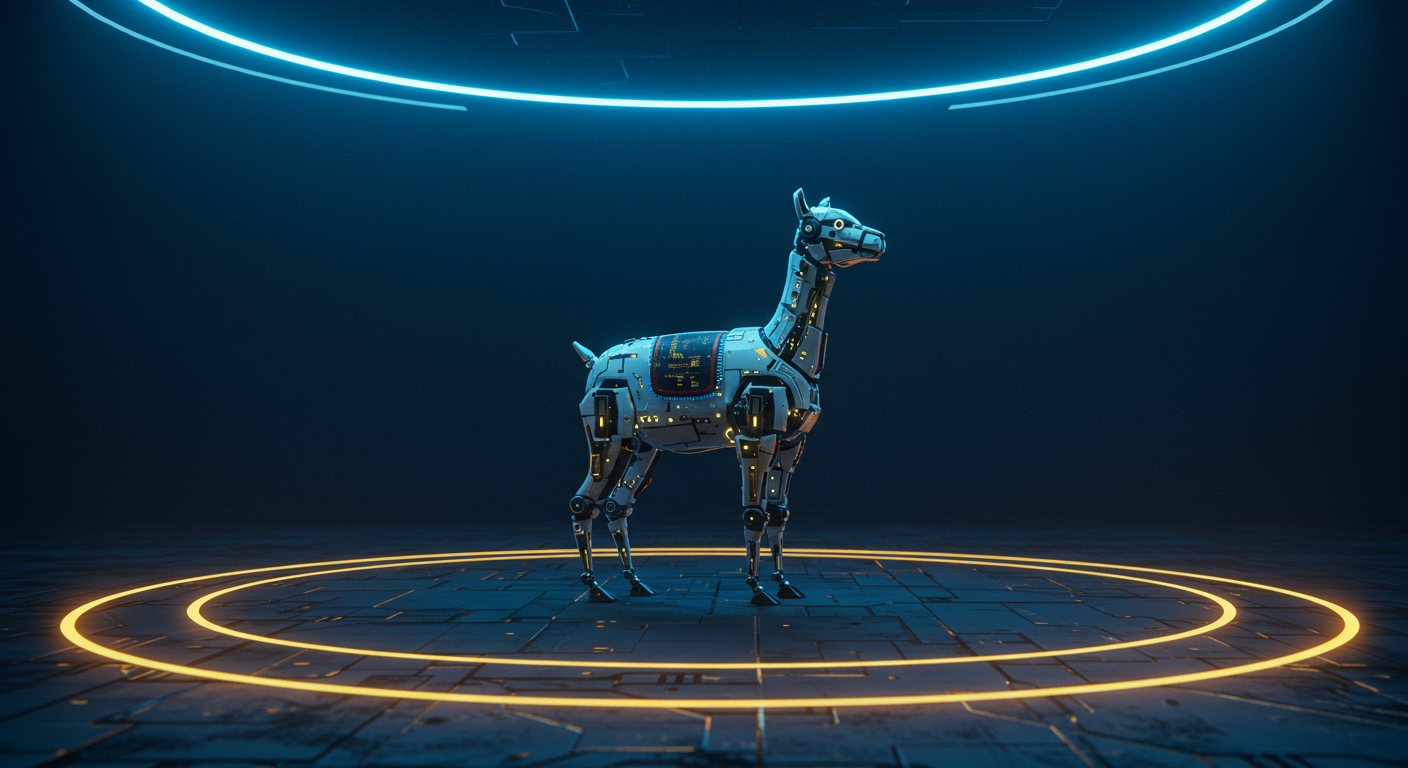OpenAI's GPT-OSS: A New Dawn for Open Source AI?

OpenAI's Paradigm Shift: Embracing Open Source with GPT-OSS
Just when you thought you had OpenAI figured out, they pull a Heisenberg and change the equation.
From Closed-Source to Community-Driven?
For years, OpenAI was synonymous with cutting-edge, but tightly guarded AI. Then, seemingly out of the blue, came GPT-OSS. This unexpected embrace of open-source models raises a few eyebrows – and a lot of intriguing questions. Why did OpenAI choose to open source now?
Why the Change of Heart?
Several factors could be at play here:
- Community Collaboration: Opening up models invites external contributions, potentially leading to faster innovation and bug fixes. Think of it as crowdsourcing brilliance.
- Accelerated Innovation: AI Enthusiasts can now freely experiment, test boundaries, and build upon OpenAI's work. This can lead to unforeseen breakthroughs and accelerate the pace of AI development overall.
- Challenging Meta: Meta has been a vocal proponent of open-source AI. Could GPT-OSS be a strategic move to compete in the open-source arena and potentially influence the direction of open AI development?
Examination of External Pressures or Internal Strategic Realignments
Perhaps external pressures from regulators or a realization that truly powerful AI requires a collaborative ecosystem influenced this change. Or maybe, internally, OpenAI recognized that even with vast resources, collective intelligence is a force multiplier. Is this the beginning of a series of releases, or a one-off experiment? Time will tell. You can track further changes in the industry at our AI News.
In essence, OpenAI's move represents a potential watershed moment, signaling a shift towards a more open and collaborative approach to AI development that could reshape the entire tech landscape.
As OpenAI makes further strides in open source AI, GPT-OSS models represent a significant leap.
GPT-OSS-120B and 20B: A Technical Deep Dive
Let's dive into the specifics of these models. GPT-OSS comes in two primary sizes: a massive 120 billion parameter model and a smaller 20 billion parameter variant.
- Model Size: The most striking difference is the scale. 120B dwarfs 20B, implying a greater capacity for learning complex patterns and relationships in data.
- Architecture: Details on the exact architecture are crucial, but assuming a standard Transformer-based setup, we can infer:
- More layers and larger hidden dimensions in the 120B model.
- Potentially faster inference speeds with the 20B, trading off raw power for efficiency.
- Use Cases: The 120B model likely targets tasks demanding nuanced understanding:
- Complex reasoning and problem-solving.
- Creative writing requiring detailed character development.
- The 20B model would shine in resource-constrained environments, think edge devices or real-time applications where speed is paramount. It can also be used by software developers for smaller coding tasks.
GPT-OSS-120B Hardware Requirements
Running these models isn't trivial. The sheer size of GPT-OSS-120B hardware requirements dictates high-end infrastructure. Think multiple high-performance GPUs with significant VRAM (likely exceeding 80GB per GPU) and robust interconnects. Optimization strategies such as quantization and pruning will be essential to make inference tractable.
Memory bandwidth is key, along with fast storage to load model weights quickly.
GPT-OSS vs. Llama 3

A comparative analysis with other open-source LLMs like Llama 3 is inevitable. While exact performance benchmarks are pending, here’s what to anticipate:
- GPT-OSS might excel in specific tasks where its larger size gives it an edge, while Llama 3 may have been trained with different optimization goals.
- The open-source nature allows community-driven improvements, making these models adaptable to a wide range of applications.
- Tools like Aider, an open-source coding tool, are prime examples of how these models can be integrated into practical applications.
It's a brave new world where even AI is becoming open source, but let’s decode the license implications of GPT-OSS before we dive in.
Licensing and Commercial Use: Understanding the Fine Print
Understanding the GPT-OSS license is crucial before integrating these powerful models into your projects. It's not quite the "wild west" of unrestricted use, but it opens doors. Think of it like this: you get the recipe, but need to understand the rules of the kitchen.
- Key License Terms: The license will detail what you can and cannot do. Pay close attention to clauses about distribution, modification, and attribution.
- Guidance for Legal Utilization:
- Read the License: Seriously, every word. This is your North Star.
- Seek Legal Counsel: If you have any doubts, a lawyer specializing in open-source licenses is your best friend.
- Attribute Correctly: Give credit where credit is due. The license will specify how to attribute the original work.
Comparing Licenses
How does GPT-OSS stack up against other open-source licenses?
| License | Commercial Use | Modification | Distribution | Attribution |
|---|---|---|---|---|
| MIT | Yes | Yes | Yes | Required |
| Apache 2.0 | Yes | Yes | Yes | Required |
| GPT-OSS | Consult License | Consult License | Consult License | Consult License |
It's less about which license is "better" and more about which aligns with your project's goals and resources.
Legal Implications and Compliance
Deploying GPT-OSS in commercial applications brings responsibilities. Ignoring the license is a quick way to find yourself in legal hot water. Proper compliance is key to not only legal safety, but also ethical development. Consider tools for Code Assistance to maintain compliance during development.
Navigating the GPT-OSS license requires careful attention, but it can unlock a whole new world of AI possibilities while ensuring privacy-conscious users can benefit. Understanding these nuances empowers developers and businesses to innovate responsibly.
Open source AI could become the collaborative engine driving unprecedented innovation, and OpenAI's potential GPT-OSS release could be the catalyst.
Democratization of AI Research and Development
Open sourcing a large language model like GPT could profoundly change the AI landscape.- Accessibility: Open source levels the playing field, enabling smaller research teams, independent developers, and even AI enthusiasts to experiment and innovate.
- Collaboration: Open source fosters community contributions. Imagine thousands of developers worldwide debugging, improving, and expanding the model's capabilities in ways OpenAI alone couldn't.
- Education: Students can deeply dissect and learn from a powerful LLM’s architecture. This could accelerate the training of the next generation of AI experts. Need help learning? The AI Explorer guide might be useful.
Community Impact and the Future of Open Source AI
The impact of GPT-OSS could ripple through the entire AI ecosystem."Imagine the possibilities: customized models for specialized fields like medicine, law, or even niche creative endeavors. The potential is limitless."
- Innovation: Open access can lead to faster innovation, as researchers are not constrained by proprietary restrictions. New architectures, training techniques, and applications could emerge.
- Competition: A robust open-source alternative to closed-source models would increase competition, pushing companies to develop better and more accessible AI. The AI Tools Directory could help you find alternative options.
Ethical considerations of open source AI models

This newfound access also brings new challenges, and we need to acknowledge the ethical side.
- Misuse: Open sourcing powerful AI models could lead to misuse. Generating misinformation, creating deepfakes, and even developing malicious code become easier.
- Bias Amplification: If the model is trained on biased data, open sourcing it without proper safeguards could amplify these biases, leading to unfair or discriminatory outcomes.
- Accountability: Determining responsibility for harms caused by open-source AI is complex. Is it the original developer, the user, or someone in between?
- There are some great articles about the ethical implementation of AI.
The allure of open-source AI continues to grow, and OpenAI’s GPT-OSS might just be the next big leap.
Getting Started with GPT-OSS: A Practical Guide
So, you’re ready to dive into the world of GPT-OSS? Excellent! Here’s a streamlined guide to get you up and running, even if your coding experience is… shall we say, “nascent.” First, a word on the GPT-OSS model -- it represents a significant step towards democratizing AI, providing access to powerful language models that can be customized for various applications.
- Download & Installation:
- Follow the
READMEinstructions for your operating system. Typically, this involves cloning the repository usinggitand setting up a Python environment withpip.
git as your time machine for code, and pip as your personal AI assistant for managing software packages.
- Example commands:
git clone [repository URL]
cd gpt-oss
pip install -r requirements.txt
- Running the Model:
- After installation, you'll likely find example scripts for running the model.
- For text generation, a simple command might look like:
python generate.py --prompt "The quick brown fox"GPT-OSS Tutorial for Text Generation
- Code Examples: For chatbot development, you'll integrate the model into a larger application, handling user input and generating responses. This is where tools like ChatGPT can be instructive (even though GPT-OSS offers more customization). Think of it as learning to paint by studying the masters.
- Optimization: Running these models can be computationally intensive. Consider:
- Hardware: A GPU is highly recommended.
- Quantization: Reducing the precision of the model's weights can significantly reduce memory usage and improve speed.
- Batching: Processing multiple prompts at once can improve throughput. You can find similar optimization guides at our Learn AI In Practice page!
Troubleshooting & Community
- Resources: Check the repository's
READMEfor common issues and solutions. Online forums and communities dedicated to open-source AI are invaluable. - Documentation: Pay close attention to parameter settings. The Prompt Engineering guide here can be very helpful!
It's no longer a question of "if" AI will be open source, but who will dominate the landscape.
OpenAI vs Meta: The Open Source AI Showdown
The battle for AI supremacy isn't just about closed-door innovations; it's increasingly about open-source dominance, and OpenAI and Meta are leading the charge in very different ways. This competition fuels innovation and accessibility, but also poses interesting questions about control and influence.
Meta's Open Embrace: Llama 3
Meta's strategy is clear: democratize AI power. With Llama 3, they offer a powerful language model, accessible to a wide audience.
- Accessibility First: Llama 3's open licensing encourages experimentation and development by both researchers and hobbyists.
- Community Focus: Meta leverages its massive community to refine and improve Llama 3.
- Strategic Goal: Drive adoption of Meta's ecosystem.
OpenAI's Controlled Opening: GPT-OSS
OpenAI is taking a more measured approach with GPT-OSS, carefully selecting components to open source.
- Targeted Releases: OpenAI strategically open-sources specific modules to foster innovation while retaining control over core technologies.
- Hybrid Approach: This "controlled open-source" allows OpenAI to benefit from community contributions without sacrificing its competitive edge.
- Strategic Goal: Shape the open-source AI ecosystem on their terms.
Comparing Llama 3 and GPT-OSS
A direct comparison reveals key differences:
| Feature | Llama 3 | GPT-OSS |
|---|---|---|
| Licensing | Fully Open Source | Selectively Open Source |
| Performance | Strong, general-purpose | Dependent on specific open components |
| Community Support | Massive and enthusiastic | Growing, but more focused |
| Accessibility | High, easy to deploy and customize | Moderate, depends on components |
To learn more about key AI concepts, you might find the AI Fundamentals guide helpful.
A Benevolent Duopoly?
Having multiple major players in open-source AI is a net positive. Competition between Meta and OpenAI will likely lead to:
- Faster Innovation: Each company is incentivized to release more powerful and accessible models.
- Greater Choice: Developers and researchers have a broader range of tools to choose from.
- Reduced Centralization: A duopoly can prevent any single entity from dominating the AI landscape.
The "OpenAI vs Meta open source AI strategy" presents a fascinating dynamic, one that will shape the future of AI development and accessibility in the years to come.
Here's a dose of reality to temper the excitement surrounding OpenAI's GPT-OSS.
Beyond the Hype: Realistic Expectations for GPT-OSS
The buzz around open-source GPT models is undeniable, and rightfully so – democratizing AI access is a noble endeavor. However, let's ground our expectations. While ChatGPT and similar models have set a high bar, expecting GPT-OSS to immediately match that performance is a recipe for disappointment.
Limitations of GPT-OSS models
Keep these points in mind about the limitations of GPT-OSS models:
- Computational Resources: Training these models requires significant computational power and expertise. Not everyone has a supercomputer humming in their basement.
- Data Quality: High-quality training data is paramount. Garbage in, garbage out, as they say. Obtaining and curating such datasets is a major undertaking.
- Performance Gaps: Don't be surprised if initial open-source iterations lag behind proprietary models in certain areas, such as nuanced understanding or complex reasoning.
Responsible Innovation in AI
Open-source doesn't absolve us of responsibility. Ethical considerations are crucial:
- Bias Mitigation: Actively work to identify and mitigate biases in training data.
- Misinformation: Implement safeguards to prevent the models from being used to generate harmful or misleading content. AI Safety is paramount.
Conclusion
GPT-OSS presents a tremendous opportunity to foster innovation and collaboration. By acknowledging the Limitations of GPT-OSS models, embracing ethical development, and focusing on continuous improvement, we can unlock the full potential of open-source AI for the benefit of all. And that’s how you make the most of today’s best AI tools.
Keywords
OpenAI open source, GPT-OSS-120B, GPT-OSS-20B, OpenAI models, large language models open source, open source AI models, AI model licensing, commercial use open source AI, AI community, future of open source AI
Hashtags
#OpenAI #OpenSourceAI #GPT_OSS #AIModels #MachineLearning
Recommended AI tools
ChatGPT
Conversational AI
AI research, productivity, and conversation—smarter thinking, deeper insights.
Sora
Video Generation
Create stunning, realistic videos and audio from text, images, or video—remix and collaborate with Sora, OpenAI’s advanced generative video app.
Google Gemini
Conversational AI
Your everyday Google AI assistant for creativity, research, and productivity
Perplexity
Search & Discovery
Clear answers from reliable sources, powered by AI.
DeepSeek
Conversational AI
Efficient open-weight AI models for advanced reasoning and research
Freepik AI Image Generator
Image Generation
Generate on-brand AI images from text, sketches, or photos—fast, realistic, and ready for commercial use.
About the Author

Written by
Dr. William Bobos
Dr. William Bobos (known as 'Dr. Bob') is a long-time AI expert focused on practical evaluations of AI tools and frameworks. He frequently tests new releases, reads academic papers, and tracks industry news to translate breakthroughs into real-world use. At Best AI Tools, he curates clear, actionable insights for builders, researchers, and decision-makers.
More from Dr.

